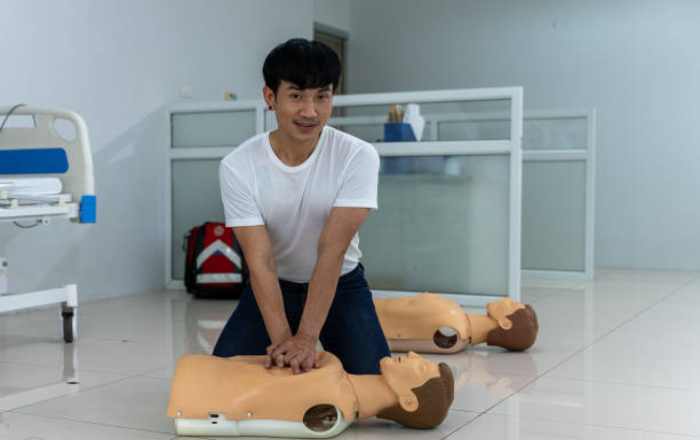CPR is the combination of 30 chest compressions followed by two breaths of mouth-to-mouth. It helps keep the person alive until medical help arrives.
If the victim is not breathing, call 911 and put it on speaker. The emergency operator can give first aid instructions.
Make sure the person is on their back and tilt their head slightly to open the airway. Listen and watch for regular breathing – grunting, snorting or gasping is not normal.
Compressions

If the person is not breathing, check that their chest rises and falls regularly. Call for help immediately.
If you can’t find a pulse, begin with CPR. This is vital to ensure that oxygen-rich blood reaches the brain and saves their life.
Firstly, place the person on their back. Put the lower palm (heel) of one hand on the center of their chest, between the nipples. Grasp their wrist with the other hand. You can interlock your fingers or put them in a fist – whatever feels comfortable for you.
Begin with 30 compressions, pushing down on their chest about 2 inches a time at a rate of 100 to 120 times per minute. After 30 compressions, pause to give the person two mouth-to-mouth rescue breaths. Repeat this cycle of 30 chest compressions followed by 2 breaths (30:2) until the person revives or more help arrives. If they respond by opening their eyes or moving limbs, stop and place them in the recovery position.
Breathing
CPR keeps a person’s blood circulating and can double or triple their chances of survival until emergency medical professionals arrive. To start, position the person on their back and open their airway by tilting their head and lifting their chin. Check to see if they’re breathing by listening for gurgling or gasping sounds, check this site out.
If they’re not breathing, call 911 and begin mouth-to-mouth resuscitation. If the person is an infant, use a two-person rescue approach. One person should do chest compressions and the other should provide rescue breaths. Using mouth-to-mouth can transfer infectious viral and bacterial diseases, so wipe away any vomit or excess saliva before contacting the victim’s lips.
To do chest compressions, place one hand on the middle of the person’s chest and put your other hand on top, interlocking your fingers. Press down firmly about 2 inches 30 times.
Ventilation
The first thing to do when a person is in cardiac arrest is call emergency services. After that, if the victim has no pulse and is not breathing, you can help keep their life-support systems working by doing CPR. This keeps oxygen-rich blood flowing to the brain and other vital organs until Emergency Medical Services can restore a normal heartbeat.
For adults, children, and infants, you can pause the chest compressions to do mouth-to-mouth rescue breaths every 10 seconds (two breaths for every 30 chest compressions). To do this, open the victim’s airway by tilting their head back and lifting their chin. If there’s anything in their mouth, pinch it closed and blow steadily into it.
You can also use an Automated External Defibrillator (AED) to shock the heart if it goes into ventricular fibrillation. This will restore the normal heartbeat and increase the chances of survival. Only trained emergency medical professionals should use an AED, though.
Intubation
The goal of CPR is to keep oxygen-rich blood circulating until emergency medical professionals arrive. Without oxygen, the brain and other organs start to die within just a few minutes. If someone stops breathing, you should begin CPR immediately.
Use both hands to put pressure on the person’s chest (called chest compressions). Push down hard and fast, using the heel of your hand and a rate of 100 to 120 compressions per minute at a depth of 2 inches. It helps to pace yourself by counting to 30, or by a song, such as the Bee Gees’ “Stayin’ Alive” or Queen’s “Another One Bites the Dust.”
Summary:
After 30 chest compressions, pause for two mouth-to-mouth rescue breaths. Pinch the person’s nose shut and tilt their head back a little with their chin up. Seal your mouth over theirs and blow gently. Repeat this sequence until the person revives or help arrives. Alternatively, you can use an automated external defibrillator (AED). See our AED page for more details on how to do this.

